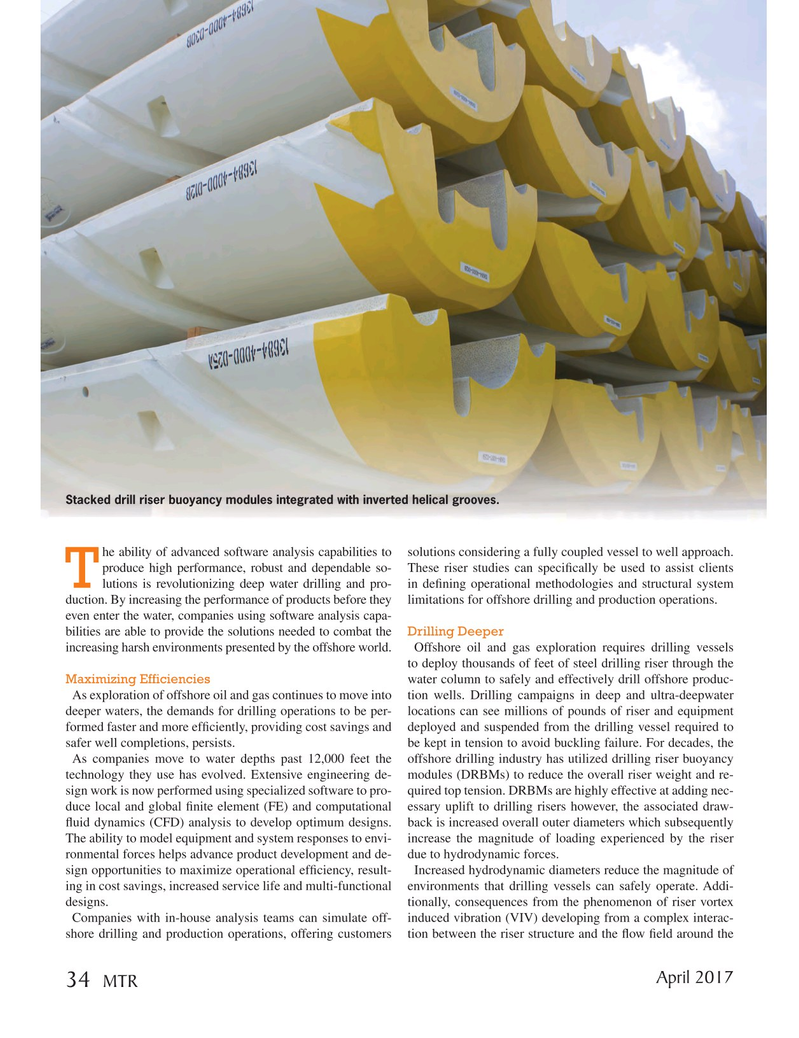
Page 34: of Marine Technology Magazine (April 2017)
Offshore Energy Annual
Read this page in Pdf, Flash or Html5 edition of April 2017 Marine Technology Magazine
Stacked drill riser buoyancy modules integrated with inverted helical grooves.
he ability of advanced software analysis capabilities to solutions considering a fully coupled vessel to well approach. produce high performance, robust and dependable so- These riser studies can speci? cally be used to assist clients
T lutions is revolutionizing deep water drilling and pro- in de? ning operational methodologies and structural system duction. By increasing the performance of products before they limitations for offshore drilling and production operations. even enter the water, companies using software analysis capa- bilities are able to provide the solutions needed to combat the Drilling Deeper increasing harsh environments presented by the offshore world. Offshore oil and gas exploration requires drilling vessels to deploy thousands of feet of steel drilling riser through the
Maximizing Efficiencies water column to safely and effectively drill offshore produc-
As exploration of offshore oil and gas continues to move into tion wells. Drilling campaigns in deep and ultra-deepwater deeper waters, the demands for drilling operations to be per- locations can see millions of pounds of riser and equipment formed faster and more ef? ciently, providing cost savings and deployed and suspended from the drilling vessel required to safer well completions, persists. be kept in tension to avoid buckling failure. For decades, the
As companies move to water depths past 12,000 feet the offshore drilling industry has utilized drilling riser buoyancy technology they use has evolved. Extensive engineering de- modules (DRBMs) to reduce the overall riser weight and re- sign work is now performed using specialized software to pro- quired top tension. DRBMs are highly effective at adding nec- duce local and global ? nite element (FE) and computational essary uplift to drilling risers however, the associated draw- ? uid dynamics (CFD) analysis to develop optimum designs. back is increased overall outer diameters which subsequently
The ability to model equipment and system responses to envi- increase the magnitude of loading experienced by the riser ronmental forces helps advance product development and de- due to hydrodynamic forces. sign opportunities to maximize operational ef? ciency, result- Increased hydrodynamic diameters reduce the magnitude of ing in cost savings, increased service life and multi-functional environments that drilling vessels can safely operate. Addi- designs. tionally, consequences from the phenomenon of riser vortex
Companies with in-house analysis teams can simulate off- induced vibration (VIV) developing from a complex interac- shore drilling and production operations, offering customers tion between the riser structure and the ? ow ? eld around the
April 2017 34
MTR
MTR #3 (34-48).indd 34 MTR #3 (34-48).indd 34 3/30/2017 11:04:49 AM3/30/2017 11:04:49 AM

 33
33

 35
35
